ASUS first introduced the ZenBook Pro Duo in Computex 2019 in Taiwan. It’s a new kind of laptop designed for heavy users and multitaskers thanks to its dual-screen design, stylus, and powerful hardware. It’s a multimedia beast with a heavy price tag. Is it worth getting or are you better off with something else? Find out in our review.
Table of Contents

The ZenBook Pro Duo has an aluminum chassis that exudes a premium look and feel to it. An ASUS logo is emblazoned on the lid. The laptop looks somewhat similar to most ASUS laptops. One issue though is that the cover tends to attract fingerprints and smudges, and it’s rather bothersome to wipe it down regularly.

While it looks similar to other ASUS laptops, the ZenBook Pro Duo comes with a pleasant surprise once the lid is lifted. Apart from the main display, the ZenBook Pro Duo has a secondary display called the ScreenPad Plus; it’s situated on the lower half of the laptop’s body. The main screen has very slim bezels, with a webcam housed on the top bezel.

Due to the secondary screen, the keyboard is placed much lower than usual. The keys have good tactility and are a delight to type on. Users would probably need to adjust to it when typing, due to cramped arrangement and bottom placement. It can also get rather tiring to use, seeing as there’s nowhere to rest the hands during typing.

The touchpad sits beside the keyboard, and it’s a placement that will take a lot of time getting used to. Another issue is that since it’s located on the right side of the device, left-handed individuals have no other choice but to use the stylus included or a separate mouse instead. On the upper corner of the touchpad, one can find a button that turns it into a virtual numpad when pressed. It’s still a pretty cool effect, and we do admit it’s a rather smart way of not compromising the numpad even in a portable device.

Located on the left are the charging port, HDMI port, USB 3.1 Gen 2 Type-A port, and the loudspeaker.
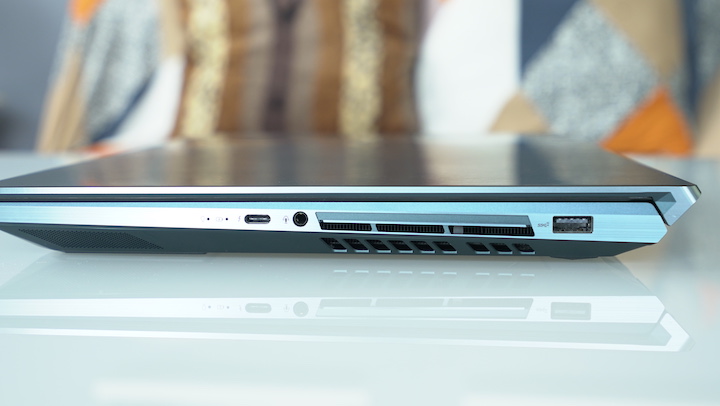
On the other side sits USB 3.1 Gen 2 Type-A port, 3.5mm audio port, another loudspeaker, an LED notification light, and a USB-C Thunderbolt 3 port.
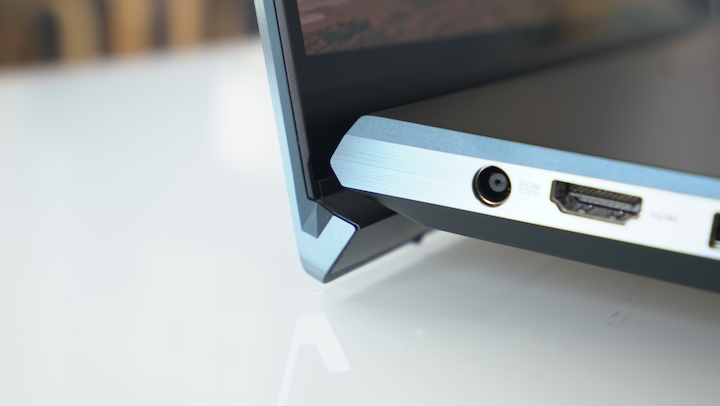
The ZenBook Pro Duo comes with an ergonomic lift hinge that elevates the laptop, allowing heat to dissipate and reduce thermal problems.

A stylus comes with the Pro Duo, giving users an option to use that to navigate. ASUS has tagged the ZenBook Pro duo as a laptop made for creatives, hence the inclusion of a stylus. The laptop’s panel is somewhat sensitive to touch, and we ran into several issues while testing it out. Sometimes, the stylus doesn’t register the click made. There are also instances when resting your palm on the screen while using the pen would confuse the laptop. It’s rather difficult to draw or navigate around while avoiding accidentally brushing your palm both on the primary or secondary screen.
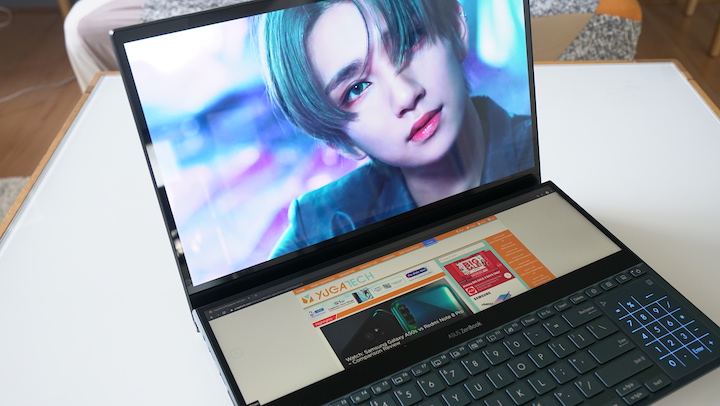
Overall, the Pro Duo looks rather sleek, thanks to its construction and design. The dual screens are certainly head-turners; after all, it’s not everyday people get to see a laptop that possesses two screens. One issue with this device, though, is that it’s incredibly hefty. We already expected it to have a slight weight because of its size, but we didn’t expect it to be a whopping 2.5kg heavy. We do wonder if it’s because of the dual screens. Either way, the Pro Duo’s weight renders a laptop’s portability useless.

The main screen of the Pro Duo is an OLED 4K panel that measures at 15.6-inches, while the ScreenPad Plus is a 4K UHD panel measuring at 14-inches. Once a desktop wallpaper is set on the main display, it also becomes the secondary display’s wallpaper. ASUS has also supplied the laptop with wallpapers that extends on both screens.
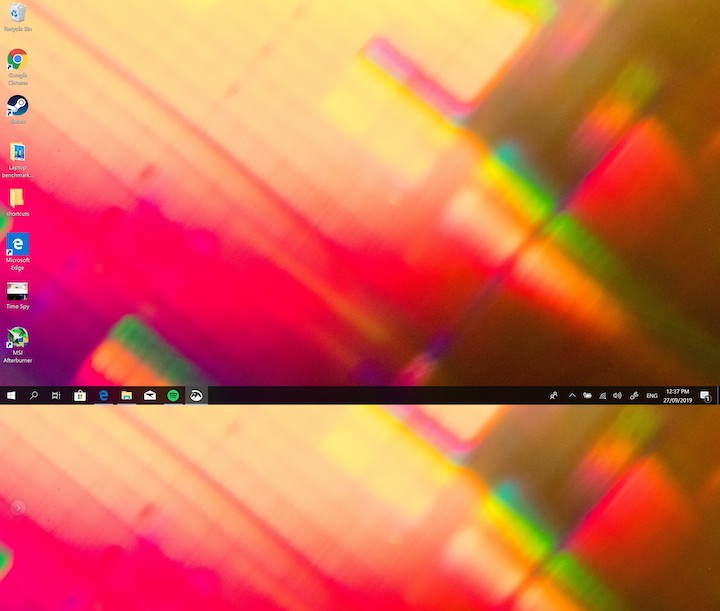
As the screens are two different panels, they don’t quite replicate the same color vibrancy. The main panel displays colors vividly and reproduces them accurately as well. It’s an absolute treat to watch videos on this screen. Almost every video I was watching was eye-catching and immersive, all due to that OLED 4K panel. It can also get incredibly bright, and there are no issues as well with its viewing angles.

The ScreenPad Plus, while a neat feature, tends to be slightly dimmer than the main one. The color reproduction isn’t entirely accurate nor vivid compared to the main screen. Similar to the main display, it’s surrounded by thin bezels, apart from its lower bezel that has the ASUS ZenBook logo. It also acts as a separator between the keyboard and the screen.

Users can work with the secondary screen as a tablet to draw or do designs on, while the main screen can be the reference screen or vice versa. Using the ScreenPad Plus as a tablet to write on was more comfortable than using the main display. Some apps on the ScreenPad Plus don’t stretch to the entire length of the panel, but when they do, it looks incredibly cool. Multitasking is not an issue with this device; individuals can put about two to three programs side by side on the ScreenPad Plus. When ASUS mentioned that they made this laptop with creatives in mind, they weren’t kidding. Content creators can utilize the ScreenPad Plus to store a workspace, references, timeline, and the like.
I tried out playing YouTube videos or Spotify on the second screen while I wrote my article on the main one. I also tried putting a reference website on the lower display, while I retained doing tasks on the main screen. Having the ScreenPad Plus house all the references was cool; there was no need to keep on switching tabs as I could instantly view what I wanted to just by looking at the lower screen.

Audio-wise, the speakers of the Pro Duo are provided by Harman/Kardon. The sound produced is good, even when set to the maximum, and it doesn’t sound ear-splitting either. Mids and highs can be heard throughout, while the lows pop-up once in a while. One has to be careful of accidentally covering up the speakers though, as it would result with the audio muffled.
Intel Core i7-9750H CPU powers up the ZenBook Pro Duo, paired up with NVIDIA GeForce RTX 2060. The laptop has 32GB of RAM and 1TB of storage onboard. Familiar Microsoft programs like Office, Edge, News, Paint 3D, and such have been pre-installed. There’s also MyASUS installed, and other third-party programs like Spotify, Netflix, Candy Crush, and McAfee are included in the laptop.
We tested out the device with several benchmarks, and here are the results:
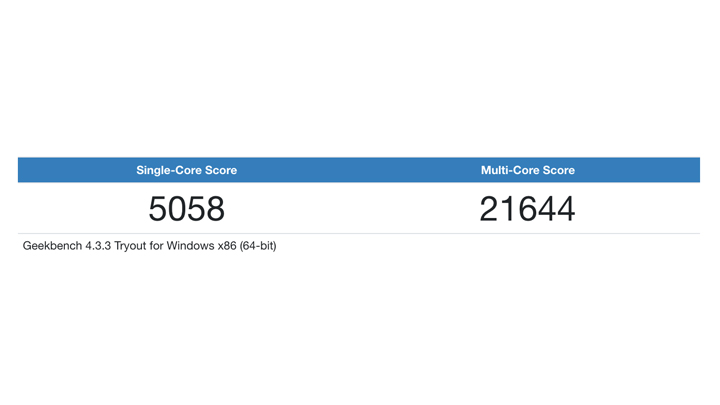

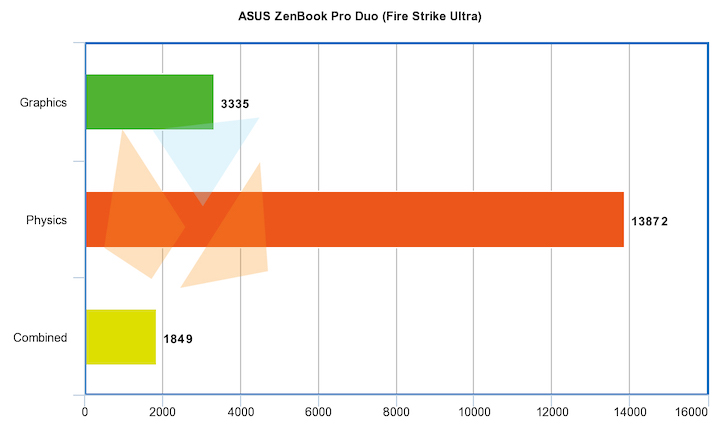
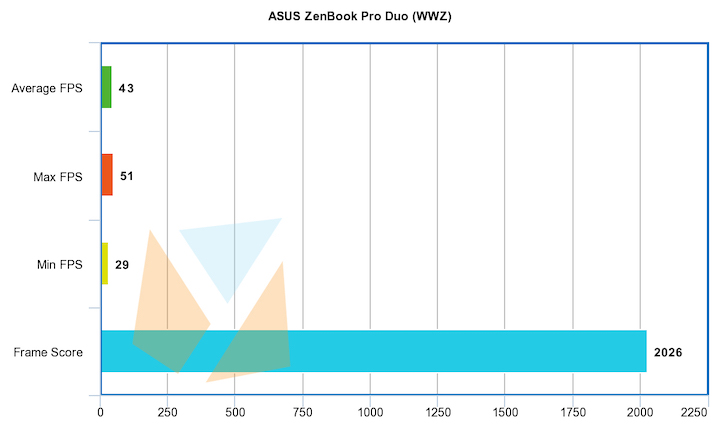
Benchmarks were run on the laptop’s native 4K resolution at ultra settings. Unfortunately, the Unigine benchmarks are maxed out at 1440p so we opted for Extreme HD at 1080p resolution for better image scaling. WWZ was also included in the synthetics since utilizes a lot of CPU cores as well as the GPU, especially when ran in Vulkan. The ZenBook Pro Duo was also ran through Cinebench R15 and R20 to see the relative performance of the i7-9750H when it comes to rendering tasks.
With its CPU, graphics card, and RAM combination, the ZenBook Pro Duo ran programs and tasks smoothly without any hitch. Dragging programs from one screen to another was pretty fluid and quite easy to do. While we’ve established that gaming is possible on the ZenBook Pro Duo, do expect that it won’t be like a gigantic version of the Nintendo 3DS. Games can only run on the main screen as the second screen cannot handle them. We have to admit though that it’s a neat party trick to have a game running on the main screen while having Spotify and a YouTube video open on the ScreenPad Plus.

Through our usual video loop test (1080p movie, 50% brightness, 50% volume with headphones, airplane mode, and balance power setting), the ZenBook Pro Duo lasted only about 6 hours and 25 minutes. One would find themselves scrambling for a charger even before the workday ends. The battery life result is most likely due to the NVIDIA RTX 2060 GPU and the secondary screen of the device.
The ASUS ZenBook Pro Duo is undoubtedly impressive. As mentioned, it’s not that common to see a laptop that’s equipped with two screens and have programs run on both of them. The hardware included is decent, and ASUS also gives users more than enough RAM to go to town and multi-task however they want. This device is definitely meant for creators and streamers who are into games.

However, even with that dual-screen gimmick, the ZenBook Pro Duo has a disappointing battery life, a cramped keyboard + touchpad placement, and has a massive weight to it that one would hate carrying around. A laptop’s main point for most creative individuals and almost every other user, after all, is portability.
Giving it a hefty weight renders that point useless; this device would probably end up staying at home with the combination of its heft and short battery life. One more con is the ZenBook Pro Duo’s price tag of PHP 169,995USD 2,897INR 245,575EUR 2,759CNY 21,096 for the i7-9750H variant, while the i9-9980HK option goes for PHP 199,995USD 3,408INR 288,913EUR 3,246CNY 24,819. There’s a whole variety of laptops out there that are priced the same or slightly lower, slimmer, lighter, and have specs as decent the ZenBook Pro Duo, or even better.
What we liked:
What we didn’t:

YugaTech.com is the largest and longest-running technology site in the Philippines. Originally established in October 2002, the site was transformed into a full-fledged technology platform in 2005.
How to transfer, withdraw money from PayPal to GCash
Prices of Starlink satellite in the Philippines
Install Google GBox to Huawei smartphones
Pag-IBIG MP2 online application
How to check PhilHealth contributions online
How to find your SIM card serial number
Globe, PLDT, Converge, Sky: Unli fiber internet plans compared
10 biggest games in the Google Play Store
LTO periodic medical exam for 10-year licenses
Netflix codes to unlock hidden TV shows, movies
Apple, Asus, Cherry Mobile, Huawei, LG, Nokia, Oppo, Samsung, Sony, Vivo, Xiaomi, Lenovo, Infinix Mobile, Pocophone, Honor, iPhone, OnePlus, Tecno, Realme, HTC, Gionee, Kata, IQ00, Redmi, Razer, CloudFone, Motorola, Panasonic, TCL, Wiko
Best Android smartphones between PHP 20,000 - 25,000
Smartphones under PHP 10,000 in the Philippines
Smartphones under PHP 12K Philippines
Best smartphones for kids under PHP 7,000
Smartphones under PHP 15,000 in the Philippines
Best Android smartphones between PHP 15,000 - 20,000
Smartphones under PHP 20,000 in the Philippines
Most affordable 5G phones in the Philippines under PHP 20K
5G smartphones in the Philippines under PHP 16K
Smartphone pricelist Philippines 2024
Smartphone pricelist Philippines 2023
Smartphone pricelist Philippines 2022
Smartphone pricelist Philippines 2021
Smartphone pricelist Philippines 2020
jae says:
I love yugatech with Seventeen,.
Dani California says:
Very nice!?
Stephany says:
about the “It can also get rather tiring to use, seeing as there’s nowhere to rest the hands during typing.” part, I recently unboxed one of these and just figured out what the 3 inch wedge it came with is for. it goes at the base closest to you and adds a great wrist support, unfortunately it detaches very easily so laptop must be on a flat surface to maximize the small wedge incline